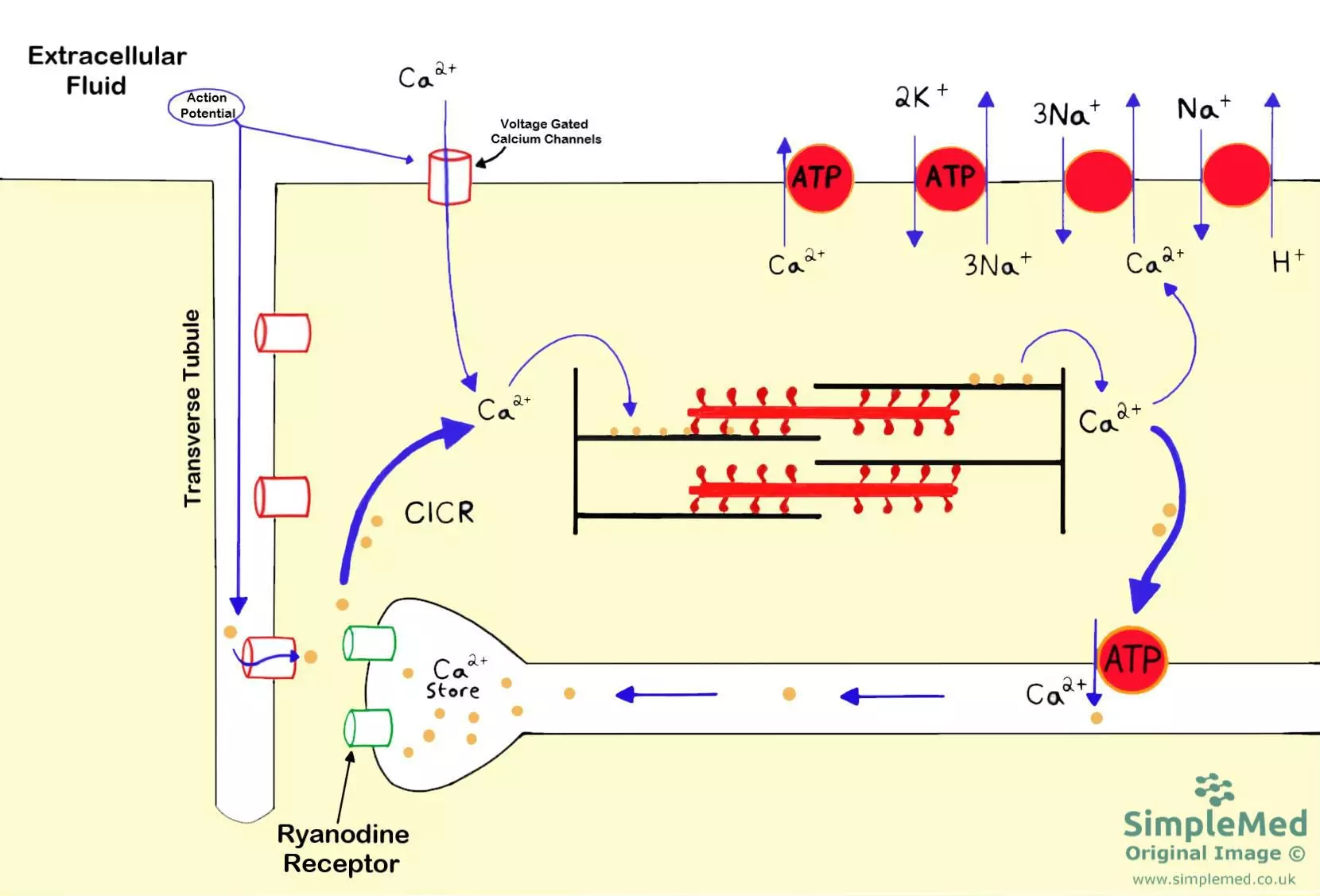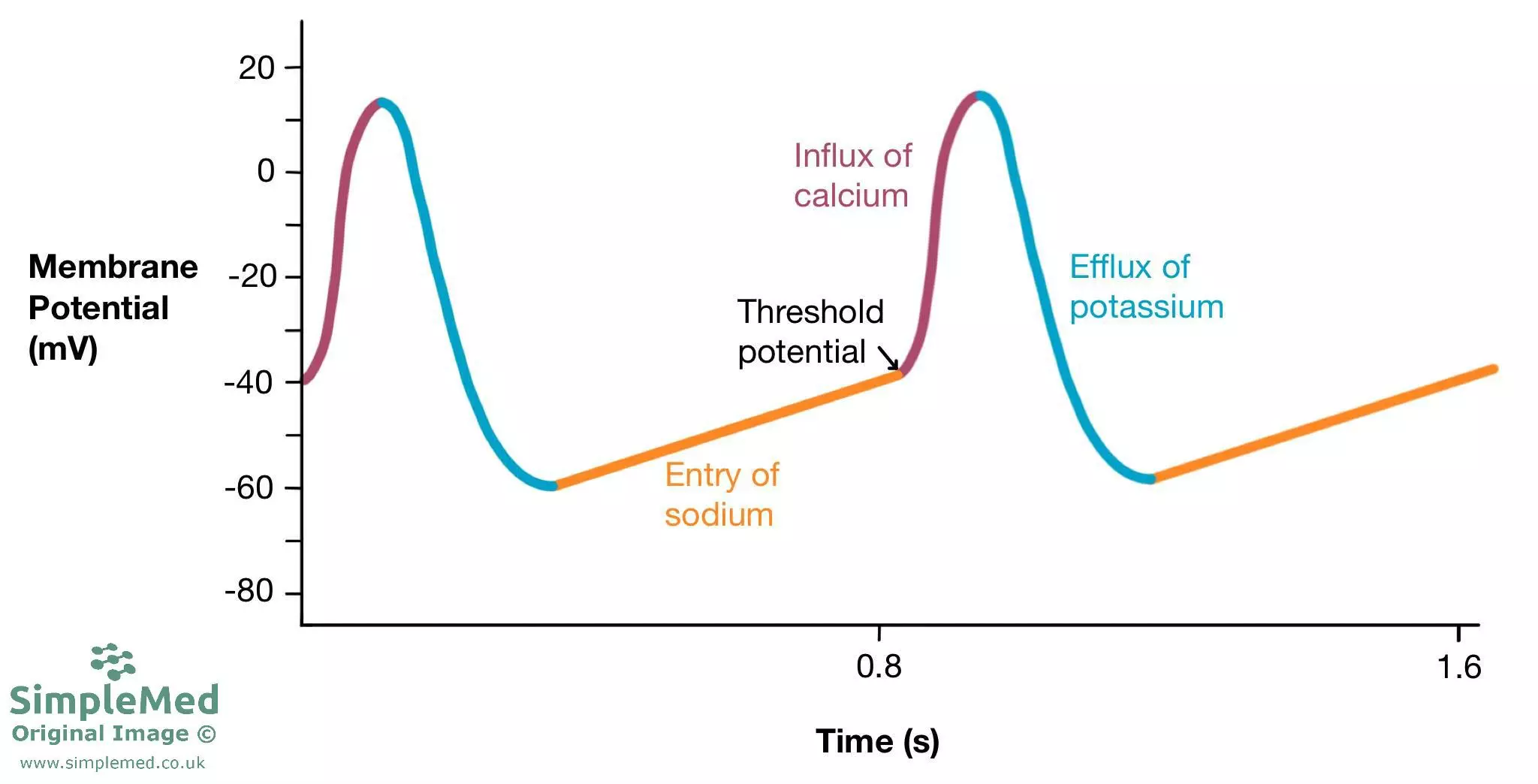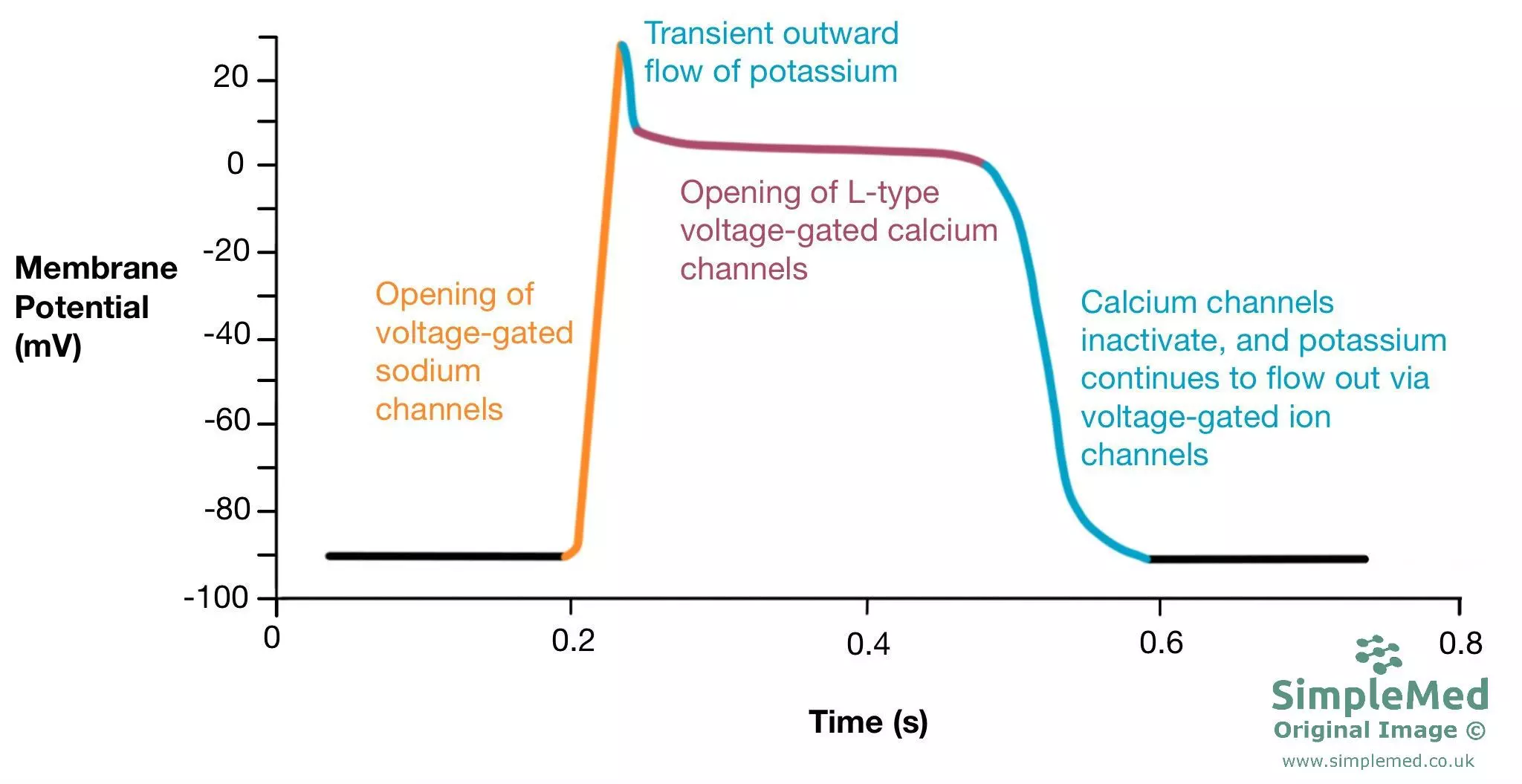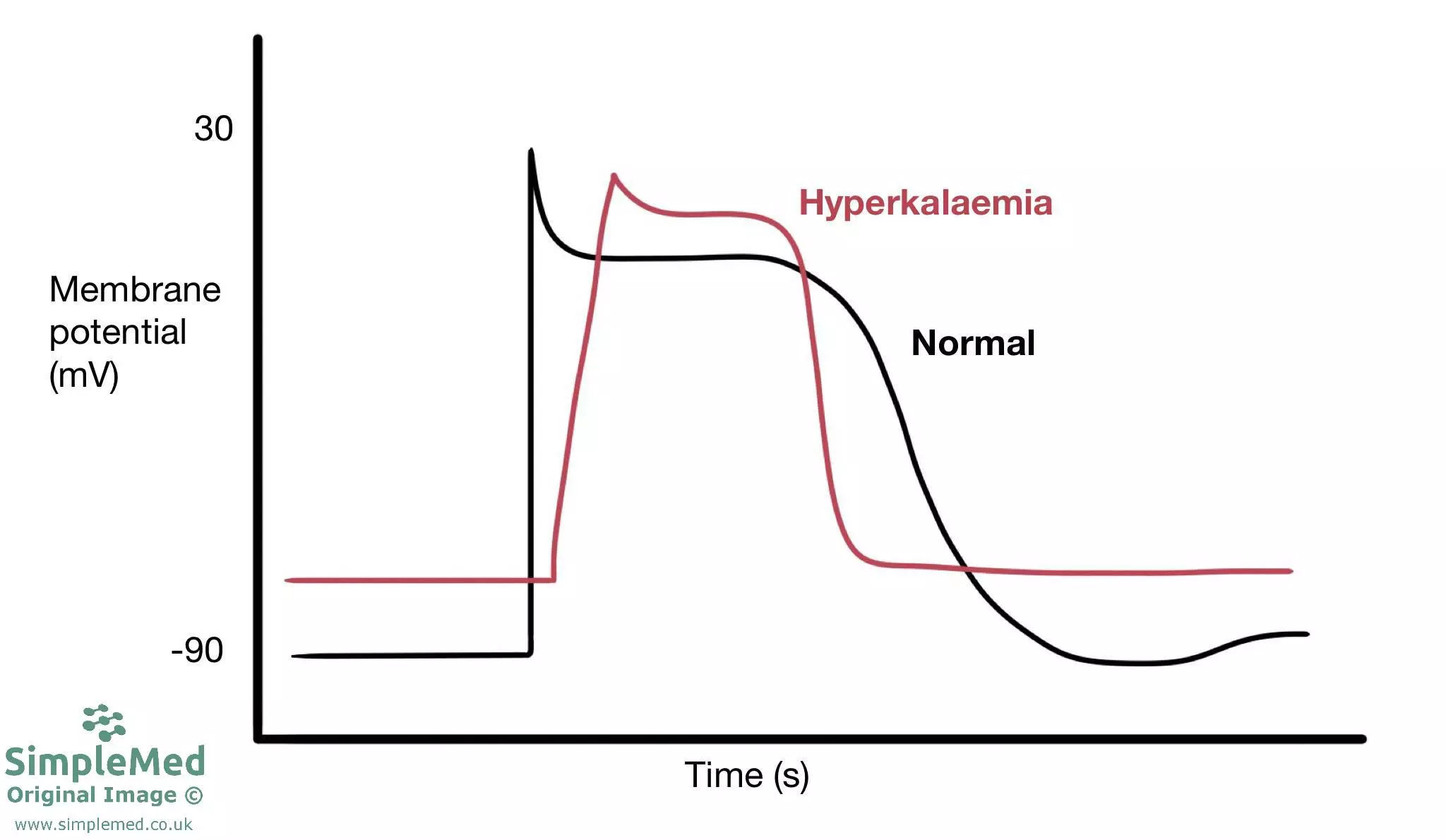By Dr. Thomas Burnell and Bethany Turner
Questions by Dr. Peter Parkinson
Next Lesson - Embryological Development of the Cardiovascular System
Abstract
- Cardiac muscle contracts upon arrival of a wave of depolarisation due to the release of Ca2+ in the sarcoplasm causing the sliding filament mechanism.
- The SA node action potential sets the heart rate due to changing of the length of the pacemaker potential.
- The shape of the ventricular action potential is due to changes in the concentration of Na+, Ca2+ and K+ in the cell during contraction.
- Hypokalaemia and hyperkalaemia affect the shape of the ventricular action potential causing symptoms.
Core
When an action potential (AP) reaches the cardiac muscle, it travels down the T-Tubules (deep invaginations of the myocyte cell membrane).
The AP causes the opening of L-type calcium channels that are found on the cell surface membrane, causing an influx of calcium ions into the sarcoplasm.
Calcium within the cell binds to ryanodine receptors on the sarcoplasmic reticulum (SR) surface resulting in the release of calcium ions from the sarcoplasmic reticulum. This is calcium induced, calcium release (CICR).
The calcium that has been released, binds to troponin C causing a conformational change in tropomyosin to expose binding sites on actin. The myosin heads bind to these sites. This then allows the sliding filament mechanism to occur and for the cardiac muscle to contract.
After contraction, most calcium is pumped back into the sarcoplasmic reticulum by sarcoplasmic reticulum calcium-ATPase (SERCA) while the rest is transported across the cell membrane back into the T-Tubules by Ca2+-ATPase and Na+/Ca2+-Exchanger.

Diagram - The events involved in muscle contraction
SimpleMed original by Thomas Burnell
The conduction system in the heart is outlined in the Cardiac Cycle article. This explains how the contraction of the heart is co-ordinated. Here, we will discuss the regulation of the electrical activity in the heart.
Sino-Atrial Node Action Potential
The cells within the Sino-Atrial (SA) node slowly depolarise triggering a wave of depolarisation which will spread through the conduction system of the heart, causing it to beat.
The pacemaker potential triggers the heart beat. The slow depolarisation of the pacemaker cells of the SA node to the threshold potential is is called the funny current (If). This depolarisation is initiated when the membrane is hyperpolarised after the previous AP. At this negativity there is opening of the hyperpolarisation-activated, cyclic nucleotide-gated Na+ channels commonly known as HCN channels. Opening of HCN channels allows a slow movement of Na+ into the cell to cause gradual depolarisation.
Once the threshold is reached, L-type Ca2+ channels open causing a fast influx of Ca2+ into the cell, causing rapid depolarisation. The potential peaks at around +20mV where the L-type Ca2+ channels inactivate and the voltage-gated K+ channels (VGKC) open to allow movement of K+ ions out of the cell to cause repolarisation.
Repolarisation lowers the potential back down to resting membrane potential, and the VGKC inactivate and close. The HCN channels activate and open, and the cycle restarts.
The sympathetic nervous system releases noradrenaline and adrenaline which can act on the β1-adrenoreceptors present on the cell surface membrane of the SA node cells. Interaction with these receptors causes a faster pacemaker potential to increase the heart rate.

Diagram - The changes in the membrane potential at the Sino-Atrial node. The orange line represents the slow depolarisation to the threshold potential (-40mV). The red line shows the rapid upstroke of the action potential. The blue line shows the repolarisation to the resting membrane potential
SimpleMed original by Bethany Turner
When the myocytes in the ventricles receive an AP from the conduction system, a special membrane potential is generated.
When depolarisation reaches the myocytes, the threshold is reached (around -80mV) and the voltage-gated Na+ channels (VGNC) open to allow an influx of Na+ ions into the cell. This is the upstroke of the AP (the orange line on the diagram below).
The AP peaks at around +20mV, where the VGNC close and there is opening of some VGKC. This results in transient repolarisation, with some K+ ions moving out the cell (small blue line).
L-type voltage-gated Ca2+ channels open and Ca2+ ions move into the cell. The influx of Ca2+ ions causes a plateau as the efflux of K+ ions is counteracted (purple line). This calcium binds to troponin C allowing muscle contraction to take place.
Once muscle contraction has occurred, there is inactivation of the Ca2+ channels and more VGKCs open to allow more K+ ions out of the cell and cause repolarisation (final blue line).
The membrane potential then reaches about -90mV where the VGKCs inactivate and shut. The myocyte then waits for the next wave of depolarisation to start the ventricular action potential again.

Diagram - The changes in the membrane potential in cardiac myocytes. The orange line represents the influx of sodium when the action potential arrives at the myocyte. There is a slight outward movement of potassium which causes a lowering of the membrane potential, represented by the blue line. This is followed by the influx of calcium into the cell which causes the membrane potential to plateau, represented by the purple line. The final blue line shows the return to the resting membrane potential by the outflow of potassium
SimpleMed original by Bethany Turner
There are changes to the ventricular action potential if a patient has hyperkalaemia or hypokalaemia:
- In hypokalaemia, there is a delay in repolarisation. This is because K+ channels do not work effectively as there is a decreased K+ ion concentration outside the cell.
- This delay in repolarisation results in increased excitability of the myocytes which increases the risk of fibrillation.
- In hyperkalaemia, there is less of a concentration gradient of K+ across the myocyte cell membrane.
- This leads to the equilibrium potential of K+ becoming less negative (closer to 0). As a result, the cell depolarises slightly.
- Some VGNCs in the cell membrane become inactivated due to the slight depolarisation, and this causes a slower upstroke in the ventricular AP.
- This slows the heart rate and can stop the heart if the K+ ion concentration is very high outside the cell.

Diagram - The solid line shows the normal ventricular AP. The dotted line shows the ventricular action potential in hyperkalaemia. The upstroke is less rapid in hyperkalaemia
SimpleMed original by Bethany Turner
Edited by: Dr. Ben Appleby
- 26235

